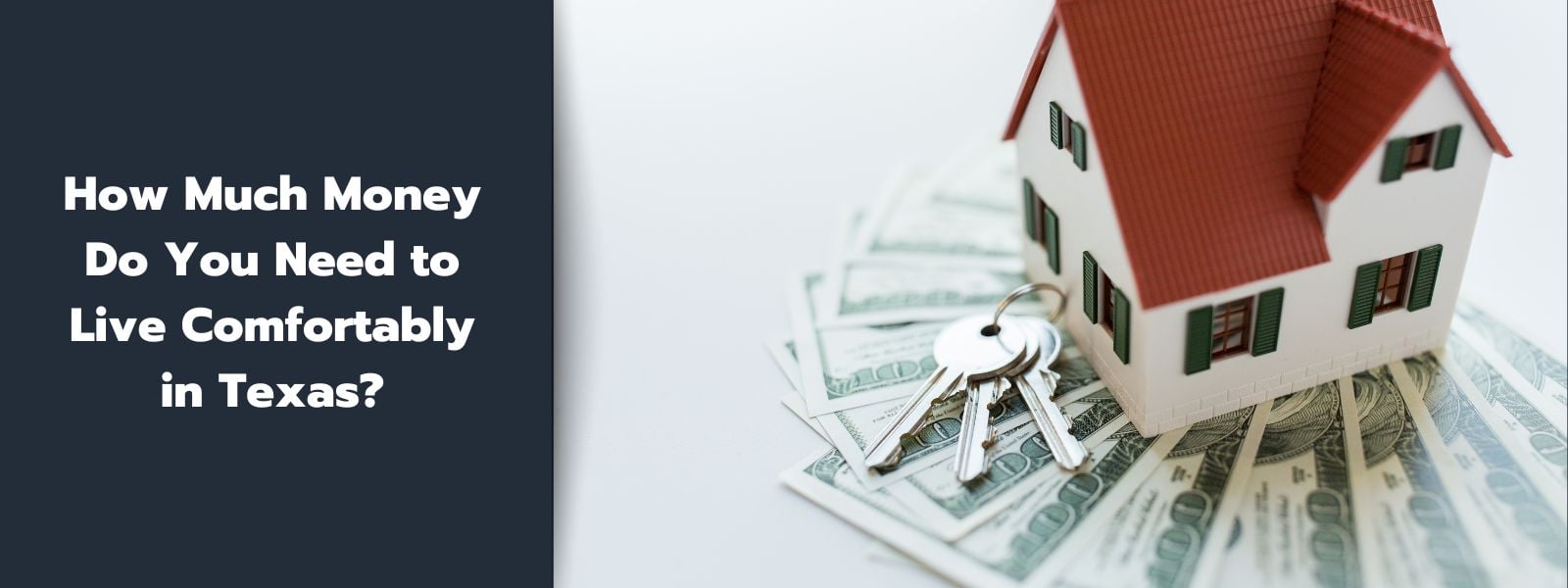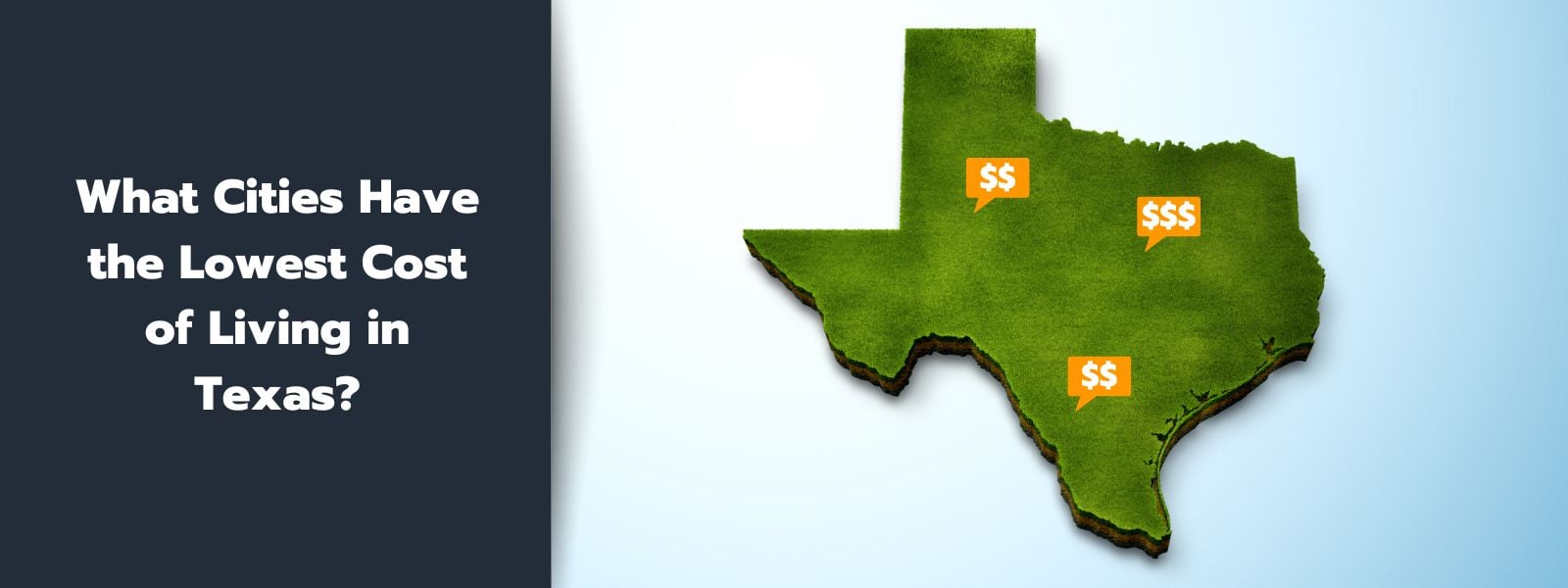Texas is widely known for its vast size, remarkable boldness, and stunning beauty, which explains why so many people are opting to relocate to the Lone Star State.
The state offers a rich array of attractions, from its charming Southern style to its delightful cuisine, vibrant music scene, and diverse entertainment options.
So, if you’re considering becoming a Texan, you might ponder whether the adage “everything is bigger in Texas” extends to the cost of living as well.
In reality, Texas boasts a reputation as one of the most budget-friendly places to reside in the entire United States.
With a cost of living approximately 8% lower than the national average, it becomes quite evident why there is a surge in individuals choosing to make Texas their home.
To assist you in your future endeavors in the Lone Star State, we have compiled a comprehensive guide that outlines the expected expenses for essentials and indulgences in Texas.
This guide covers a range of expenses such as housing costs, utilities, food expenses, and more, offering valuable insights to help you better prepare for a potential relocation.

What is the Average Cost of Living in Texas?
Texas is widely known for being big in pretty much every way possible. People often associate the state with size, thinking everything there must cost a fortune.
Surprisingly, Texas boasts an average cost of living that is 7% lower than the national average. It’s like getting more bang for your buck down south!
Given that Texas is the second largest state in the U.S.—coming in after Alaska (shh, let’s not mention this to Texans)—there is quite a range in living costs. Depending on where you are within the state, you might find cities that are anywhere from 23% cheaper to 12% pricier compared to the average U.S. city.
According to 2021 data from the Bureau of Economic Analysis, the average total personal consumption expenditure (PCE) in Texas was $45,114 per year. That breaks down to a monthly average of $3,760 per person.

What Does the Cost of Living Include?
To find the cost of living, look at various expense categories, then calculate their average. In the United States, the baseline is 100, with each category having a number showing it’s above or below the national average.
For instance, if housing is rated at 97, it’s 3% cheaper than the US average. If it’s 103, it’s 3% more expensive.
Below are the seven categories typically used to determine the cost of living:
- Housing
- Utilities
- Groceries
- Transportation
- Healthcare
- Taxes
- Miscellaneous Goods & Services
Let’s see how Texas compares to the national average.
| Cost of Living Category |
Texas |
U.S. |
| Housing |
84.4 |
100 |
| Utilities |
103.3 |
100 |
| Groceries & Food |
90.8 |
100 |
| Transportation |
92 |
100 |
| Health Care |
94.8 |
100 |
| Miscellaneous |
96.7 |
100 |
| Total |
92.6 |
100 |
Housing: How Much Does Housing Cost in Texas?
Texas stands out for its attractive housing affordability, a significant advantage for those looking to buy or rent a place to call home in the state. The diversity of price options caters to a wide range of home-buying budgets. This makes it a more financially accessible choice compared to numerous other states across the country.
When it comes to housing expenses, Texas boasts costs nearly 16% below the national average, making it a compelling destination for individuals and families seeking a more affordable living situation.
In contrast to the national median home price that exceeds $291,000, Texas presents a more cost-effective option with a median price of $243,600, illustrating its affordability and appeal to potential residents.
Below is a list of the median listing prices of homes in the biggest cities in Texas:
- Austin Homes: around $570,000
- Dallas Homes: around $420,000
- Houston Homes: around $350,000
- San Antonio Homes: around $290,000
Given the size of Texas, there are plenty of suburbs and smaller cities with even more affordable home prices. A few examples from around the state include:
- Round Rock Homes (near Austin): around $450,000
- Arlington Homes (near Dallas): around $340,000
- San Marcos Homes (between Austin & San Antonio): around $360,000
- Lubbock Homes (Northwest Texas): around $240,000
Utilities: What’s the Average Cost of Utilities in Texas?
Texas operates a deregulated energy market, promoting competitive electricity prices. Summer often sees the highest electricity bills, mainly due to air conditioning. The larger the area you’re cooling, the costlier your bill.
Electricity rates in Texas typically vary from 10.4 to 20.7 cents per kilowatt-hour, with most residences facing rates around 14–15 cents. By comparison, the national average rate ranges from 16 to 17 cents.
Interestingly, despite the heat, water bills in Texas are generally lower than the national average. It’s common to find higher water bills in small towns versus larger cities due to the divided cost of water transportation among fewer residents.
The average water bill across Texas stands at approximately $37 monthly. Since a significant portion of residential water usage is for outdoor purposes, adopting low-maintenance landscaping like xeriscaping can further reduce water expenses.
Certain Texas cities implement sustainability programs that aid in cutting utility costs. Austin, for instance, is influenced by energy-efficiency initiatives from its primary provider, Austin Energy, impacting the city’s cost of living.
Understanding the utility expenses in your target city can assist in effectively managing your budget. Researching utility costs in different Texas cities is crucial if you’re planning a relocation to align with your financial objectives.
Groceries & Food: What’s the Average Cost of Groceries & Food in Texas?
Grocery prices in Texas vary from city to city. Some cities offer prices lower than the national average, while others have prices slightly higher prices. For example, San Antonio’s grocery cost index is 91.4, which means grocery prices are 8.6% lower than the national average.
A single person living in Texas can expect to spend around $280 on groceries each month. For a family of four, groceries are around $200 per week.
To help save money when grocery shopping in Texas, consider visiting local markets and taking advantage of tax-free days and other discounts. By being strategic with your grocery shopping, you can stretch your budget and enjoy the amazing food scene Texas has to offer.
Transportation: What Are the Average Transportation Costs in Texas?
With the exception of major cities in Texas, most residents heavily depend on their cars for transportation. Overall, transportation costs are usually in line with the national average, although they can be notably lower in certain cities.
Good news: Texas holds the #2 spot among the 10 least expensive states for gasoline. So, refueling your tank won’t cost you a fortune.
If you opt for public transportation, there are various choices available. Many downtown areas are serviced by prominent bus routes, and there are also rideshare programs like Uber and Lyft. Depending on your location, walking or biking to work might even be feasible.
Healthcare: How Much Does Healthcare Cost in Texas
Healthcare costs in Texas vary, with some cities having lower costs than the national average. For instance, Houston offers relatively affordable healthcare compared to the state’s other large cities, with a cost index of 95.1.
Houston also boasts excellent healthcare accessibility due to the presence of the Texas Medical Center, the world’s largest life sciences hub. Austin’s healthcare costs slightly exceed the national average with an index of 101.6. Overall, Texas matches the national average for healthcare costs.
On average, across all tiers of health plans, health insurance costs about $470 per month. For a 40-year-old opting for a Silver-tier plan (typically ideal for the average consumer), the monthly cost would be around $590.
If you are thinking about moving to Texas, it’s crucial to research healthcare expenses in the city you are considering to ensure you can afford the necessary healthcare services. Moreover, taking proactive steps to maintain good health can lead to lower healthcare expenses in the future.
Taxes: How Much Will I Pay in Taxes in Texas?
Living in Texas has a big perk: no state income tax, giving residents a chance to save significantly. However, Texas residents face a 6.25% state sales tax and an overall average sales tax of 8.2%. Property taxes in Texas run high, with an average effective rate of 1.8%.
Yet, some parts of Texas offer lower property taxes and several exemptions for homeowners.
Remember, despite the absence of income tax in Texas, it’s crucial to account for other taxes like sales and property taxes as you plan your life in the Lone Star State.
Miscellaneous Goods & Services
Miscellaneous costs encompass a broad range of items and services, spanning from typical restaurant fare, clothing, leisure activities, and personal grooming. In the state of Texas, these expenses vary significantly. For example, Harlingen is 21% cheaper than the national average, while Plano is 14% higher.
Corpus Christi is quite representative of Texas cities when it comes to miscellaneous costs, ranking 3% below the national average. For instance, in Corpus Christi, you could indulge in a pizza for $13, treat yourself to a haircut for $17, and purchase a shirt for $38. In comparison, these same items would cost around $11, $20, and $31 respectively in an average U.S. city.

How Much Money Do I Need to Live Comfortably in Texas?
“Living comfortably” varies from person to person and the amount needed to do so in Texas depends on factors like housing expenses in your area and personal choices. If you opt for a place with cheaper housing, you might require less money than the average.
According to the US Census, the median household income in Texas is $63,826. That median doesn’t mean you have to make that much to live anywhere in the state; it’s just the average.
When determining how much you need to earn to live in Texas, keep the following in mind:
- Where You’ll Live (what city)
- Spending Habits
- Needs/Preferences for Housing, Transportation, etc.
- Household Size
- Single or Dual-Earner Household
A study by GoBankRate found that a salary of around $55,560 is the minimum for “emotional well-being.” In major cities like Dallas and Houston, a salary in the low $60,000s is a good starting point.
Some estimates suggest that living comfortably could require as much as $80,000. Generally, aiming for an income between $56,000 and $80,000 is a good goal, translating to an hourly wage of $26.92 to $38.46.
Your required minimum income will also hinge on the size of your household. For instance, according to MIT’s Living Wage Calculator, a single adult in the Dallas-Fort Worth–Arlington, TX-area needs about $22.78 per hour for a ‘Living Wage.’
A two-person household with both members working should aim for $15.40. In a four-person household with two earners, the target is around $25.78 per hour.
To figure out how much you need to live comfortably in Texas, it’s crucial to assess your personal finances and devise a budget tailored to your specific needs and lifestyle. Use tools like cost of living calculators and seek guidance from real estate professionals to find the perfect city and home that fit your financial aspirations.

What Cities Have the Lowest Cost of Living in Texas?
If you’re seeking budget-friendly cities in Texas, check out Lubbock, Amarillo, Brownsville-Harlingen, Waco, El Paso, San Antonio, and Houston. These cities have notably lower living costs than the national average, making them appealing options for people looking for an economical lifestyle. Some of the most affordable metropolitan areas in Texas include Midland-Odessa, Lubbock, Amarillo, and Abilene.
Each of these cities has its own distinctive appeal, ranging from Houston’s lively urban vibe to San Antonio’s rich historical and cultural heritage. By exploring these cost-effective cities and assessing how they align with your financial objectives, you can discover the ideal place to settle down in the Lone Star State.

What’s the Cost of Living in Texas vs. California?
The top state people are moving to Texas from is California. According to data from the U.S. Census Bureau, in 2022, 102,442 Californians moved to Texas, meanwhile, only 42,279 Texas moved to California.
One of the biggest reasons so many Californians are relocating to Texas is the dramatic difference in the cost of living. To illustrate the difference in costs, let’s use the cost of living index to see what it would be like, cost-wise, moving from a popular city in California to a popular city in Texas:
| Cost of Living Category | Austin, TX | San Francisco, CA | Cost Difference |
| Total | 101.8 | 188.7 | 46% less |
| Housing | 113.4 | 344.2 | 67% less |
| Utilities | 95 | 133.9 | 29% less |
| Groceries | 92.3 | 130.3 | 29% less |
| Transportation | 87 | 146.4 | 41% less |
| Healthcare | 105.8 | 123.6 | 14% less |
| Miscellaneous | 101.3 | 122.7 | 17% less |
The cost differences between San Francisco and Austin are pretty staggering. It’s unsurprising that so many people are opting to relocate to the much more affordable, Lone Star State.

Wrapping Up Our Guide to the Cost of Living in Texas
Moving to Texas can offer an affordable and fulfilling experience.
To decide where to live in Texas, research living costs in various cities and align them with your budget.
Besides evaluating living expenses, it’s crucial to look into the job market, local amenities, and overall quality of life.
Texas, with its diverse cities, robust job market, and lower living costs compared to the national average, provides an appealing choice for those seeking a cost-effective and enriching lifestyle.
Finding a real estate agent that you can trust and rely on when moving to Texas is essential.
Helen Painter Group Realtors is here to offer our local expertise and knowledge of the area.
A long-standing and trusted Fort Worth real estate agency, we’ve been serving buyers and sellers since 1958.
With over six decades of success behind us, you’ll surely have peace of mind knowing your best interests are being represented each step toward buying or selling a home.
To learn more or speak with an agent, feel free to give us a call at (817) 923-7321 or contact us.

